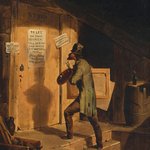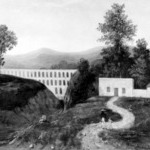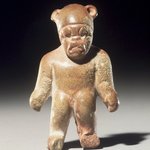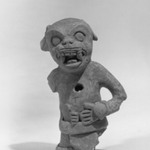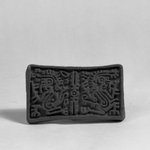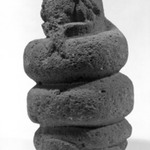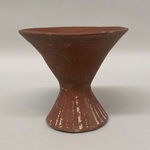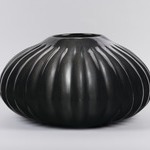Man Carrying a Cacao Pod
Arts of the Americas
The importance of maize (corn) and chocolate, two of the many plants native to the Americas, is exemplified by these Aztec sculptures.
The relief panel of the maize goddess Chicomecóatl may have been set into an altar. Chicomecóatl controlled the positive and negative powers of growth and famine. Her elaborate headdress is topped by two ears of corn. In her right hand, she holds a snake-shaped rattle staff, used to penetrate and fertilize the soil.
The man carrying a cacao pod may represent one of the merchants who brought cacao beans from the tropical coastal lowlands to the Valley of Mexico. Chocolate, made from the beans of the cacao pod, was a popular drink in Aztec society.
MEDIUM
Volcanic stone, traces of red pigment
DATES
1440–1521
DIMENSIONS
14 1/4 x 7 x 7 1/2in. (36.2 x 17.8 x 19.1cm)
(show scale)
ACCESSION NUMBER
40.16
CREDIT LINE
Museum Collection Fund
PROVENANCE
Prior to 1940, provenance not yet documented; before 1940, acquired by Guillermo M. Echániz of Mexico City, Mexico; February 14, 1940, purchased from Guillermo M. Echániz by the Brooklyn Museum.
Provenance FAQ
CATALOGUE DESCRIPTION
Figure of a man carrying a cacao pod. Left hand holds stem attached to top of pod; right hand rests on middle of pod. Eyes and mouth are open. Traces of red pigment are visible around mouth, ear and central ornament on figure's headdress. Figure wearing traditional loincloth (maxtlatl).
Condition: good; right arm is cracked and repaired; feet are broken off; small section of stone on finger near knuckle of right hand is missing; some surface chipping overall.
MUSEUM LOCATION
This item is not on view
CAPTION
Aztec. Man Carrying a Cacao Pod, 1440–1521. Volcanic stone, traces of red pigment, 14 1/4 x 7 x 7 1/2in. (36.2 x 17.8 x 19.1cm). Brooklyn Museum, Museum Collection Fund, 40.16. Creative Commons-BY (Photo: Brooklyn Museum, 40.16_front_PS9.jpg)
IMAGE
front, 40.16_front_PS9.jpg. Brooklyn Museum photograph, 2013
"CUR" at the beginning of an image file name means that the image was created by a curatorial staff member. These study images may be digital point-and-shoot photographs, when we don\'t yet have high-quality studio photography, or they may be scans of older negatives, slides, or photographic prints, providing historical documentation of the object.
RIGHTS STATEMENT
Creative Commons-BY
You may download and use Brooklyn Museum images of this three-dimensional work in accordance with a
Creative Commons license. Fair use, as understood under the United States Copyright Act, may also apply.
Please include caption information from this page and credit the Brooklyn Museum. If you need a high resolution file, please fill out our online
application form (charges apply).
For further information about copyright, we recommend resources at the
United States Library of Congress,
Cornell University,
Copyright and Cultural Institutions: Guidelines for U.S. Libraries, Archives, and Museums, and
Copyright Watch.
For more information about the Museum's rights project, including how rights types are assigned, please see our
blog posts on copyright.
If you have any information regarding this work and rights to it, please contact
copyright@brooklynmuseum.org.
RECORD COMPLETENESS
Not every record you will find here is complete. More information is available for some works than for others, and some entries have been updated more recently. Records are frequently reviewed and revised, and
we welcome any additional information you might have.
Was chocolate like money for the Aztecs?

Yes! For the Aztec cacao beans were prized trade items. Though they weren't as valuable as gold, textiles or axes, cacao was used for trade most certainly!
What was the red pigment made out of on the Man Carrying Cacao pod Aztec sculpture?
This pigment on this particular sculpture has not been scientifically analyzed so we aren't certain, but some of the reds that the Aztecs may have used include cinnabar, iron oxides, and cochineal.
Thanks!
Can you tell me more about this?

In this sculpture, a man is shown carrying a cacao pod, the beans from which would have been used to create chocolate. Unlike a great deal of Aztec sculpture that has ritual connotations, this sculpture is believed to be purely secular. This is also a great example of naturalism in Aztec sculpture.

















